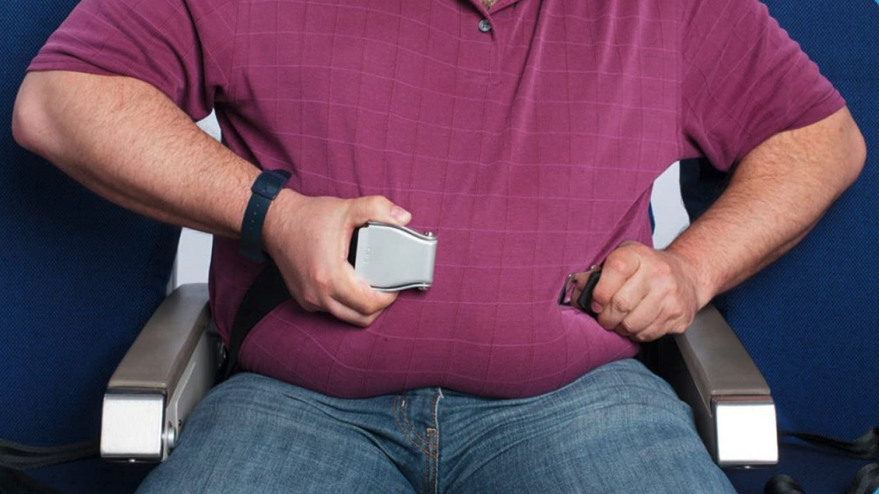It’s horrible that it still happens in this day and age, but people of size are subject to stigmatization, bullying, prejudice, and discrimination on a regular basis. Adults who are overweight or obese face sizeism at work, at the doctor’s office, and in romantic relationships. Weight is one of the top reasons why children are bullied at school. And unlike many other forms of bias that are unfortunate parts of American culture, such as racism, sexism, and ageism, discrimination based on body size is legal in almost every state.
The problems of people of size when traveling by plane have been documented extensively. Plane seats are getting more and more narrow while Americans, on the average, are getting heavier and, with that, wider. Many non-overweight passengers complain, some quite loudly, when a person of size sitting next to them is big enough that they’ve encroached on the “boundary” between them (although I had a much different experience when that recently happened to me). Meanwhile, each airline has its own rules for those who don’t comfortably fit in their respective planes’ seats, and some are significantly fairer than others.
Of course, some larger people don’t necessarily need to have 2 seats, but just a longer seat belt. Airlines offer passengers seat belt extenders for that very reason. The size of seat belts and seat belt extenders vary from airline to airline and most, if not all airlines require you to use THEIR seat belt extender, not one you buy on eBay or Amazon and bring yourself (they want to make sure the seat belt you use is FAA approved. More on that in a second.).
And what is a nickname for these airline-supplied, FAA-approved seat belt extenders?
Fatso belts.
I know, I know. Before anyone’s knickers get all twisted, it honestly looks like the nickname wasn’t invented by some heartless cretin trying to be hateful, or even as a version of self-depreciation humor by a person of size. It’s unfortunate, but that’s actually exactly how the seat belt extenders are labeled.
As (apparently) written by a flight attendant on an aviation message group:
HOLY CRAP!
So, of course, I had to do some research. Here’s what I found out.
The first part, FAA, stands for, of course, the Federal Aviation Administration, which is the largest transportation agency of the U.S. government and regulates all aspects of civil aviation in the country as well as over surrounding international waters.
TSO, I discovered, stands for Technical Standard Orders. From the FAA: “A TSO is a minimum performance standard for specified materials, parts, and appliances used on civil aircraft.”
Here’s a little more in-depth explanation from SOFEMA Aviation Services:
What is a TSO
A TSO is a minimum performance standard for specified materials, parts, and appliances used on civil aircraft. TSOs represent FAA standardization that reflects standards that the FAA has deemed to be both safe and beneficial.
A TSO, is an FAA published specification identifying a minimum performance standard for specified materials, parts and appliances used on civil aircraft.
It may specify additional factors or operating parameters as well as other minimum specifications that apply to an article.
TSO articles may in principle be used on a wide variety of aircraft. However the installation of a new TSO article will require modification approval which could be for example supplemental type certificate (for alterations that are also major changes to the type design) and field approval.
And that’s why U.S. seat belt extenders are labeled with the ironically unfortunate term of being “FAA TSO” approved (well, really “Conforms to FAA TSO”). Which leads them to sometimes being called a “Fatso belt.”
If it’s ANY help, virtually ANYTHING made according to the FAA’s TSO has a similar label (and can also be found on eBay or Amazon), the same as seat belt extenders.
Life vests.
Pilot headsets.
Plane parts.
It’s just unfortunate that seat belt extenders labeled with FAA TSO can be called…well, you know.
Crazy huh?
Y’all, I couldn’t make that one up if I tried. But now you know.
Want to comment on this post? Great! Read this first to help ensure it gets approved.
Want to sponsor a post, write something for Your Mileage May Vary, or put ads on our site? Click here for more info.
Like this post? Please share it! We have plenty more just like it and would love it if you decided to hang around and sign up to get emailed notifications of when we post.
Whether you’ve read our articles before or this is the first time you’re stopping by, we’re really glad you’re here and hope you come back to visit again!
This post first appeared on Your Mileage May Vary
Join our mailing list to receive the latest news and updates from our team.

